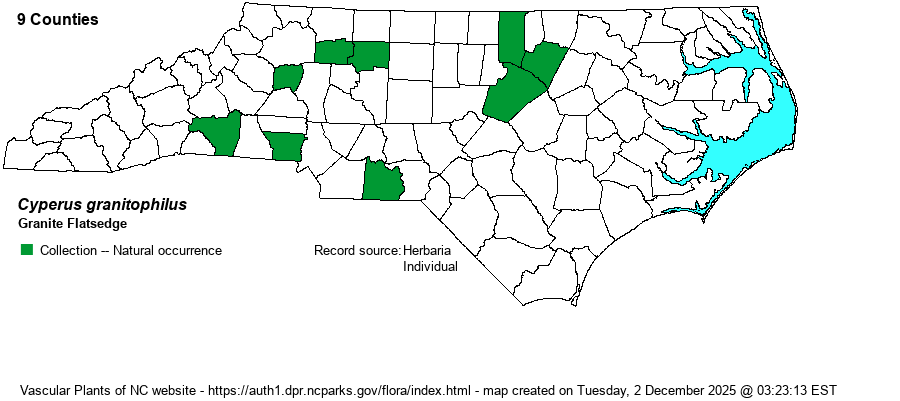| Author | McVaugh | |
| Distribution | Piedmont only, and localized to granitic flatrocks and to a mafic outcrop in Granville County. Specimens from 9 NC counties were annotated as granitophilus by experts.
VA and TN south to GA and AL. | |
| Abundance | Rare, though present at roughly 15 sites, according to the NCNHP database. Even in suitable habitat, this species does not generally produce large populations. This is a State Threatened species. | |
| Habitat | In NC, essentially restricted to granitic flatrocks, often at the edges in moss/lichen mats; a single site on a diabase flatrock. Beware: C. squarrosus can occur at the same flatocks, and thus a Cyperus at a flatrock is not automatically this rare species. |
| Phenology | Flowering and fruiting July-October. | |
| Identification | A very short plant (mostly 3-5 inches), with several or more stems from one base. At least one of the leafy bracts sticks up erect and far surpasses the inflorescence. Very close to C. squarrosus, but it differs in its longer anthers (0.8-1 mm long vs. 0.2-0.3 mm), wider floral scales (1-2 mm wide vs. 0.5-1 mm), and absence of a stipe at base of achene. | |
| Taxonomic Comments | None
The genus Cyperus is mostly tropical and warm-temperate in distribution; thus, in NC it is much commoner in the Coastal Plain than in the Mountains and Piedmont. Most species have 1-few flowering stems (culms) from grasslike basal leaves, plus a few stem leaves. At the summit is an inflorescence of very open and branched, or tightly packed, spikes, varying among species from brown to golden brown to straw-color to reddish. The arrangement of the spikelets is important, whether like a hand (digitate) or in paired or alternate rows (pinnate); as is the shape of the achene (seed), whether bi-convex in cross-section or triangular. As a group, Cyperus tends to be weedy and readily enters disturbed ground; this is true for many natives as well as all the aliens. In recent years, following DNA research, the genus has incorporated several genera that in RAB (1968) or other manuals were separate: Hemicarpha, Lipocarpha, and Kyllinga. | |
| Other Common Name(s) | Granite-loving Flatsedge | |
| State Rank | S1S2 | |
| Global Rank | G3G4 | |
| State Status | T | |
| US Status | | |
| USACE-agcp | FACW link |
| USACE-emp | FACW link |

